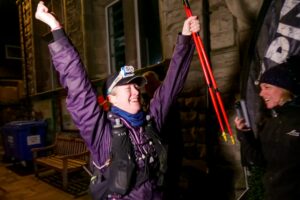What’s so special about the Spine race?: Britain’s most brutal long-distance race has a cult following, but what is it that keeps bringing us back?
As the snowstorms clear from the Cheviots and the ice balls melt from the runners’ shoelaces, the Spine stories come thick and fast. From blogs to podcasts and poems, the race is an experience that people feel a need to capture and to reflect on. These are not race reports focusing on performance in the pace/place sense (hours and minutes fall away when you’re covering 268 miles in one go). According to Paula Bedford, volunteer, ultrarunner and coach at Camino Ultra (https://www.caminoultra.com), these are stories of ‘taking a step into the unknown’. A seven-day, non-stop, ultramarathon along the 268-mile (431km) Pennine Way National Trail, the Spine Race has established itself as one of the world’s toughest endurance events. The inaugural Spine Race took place in 2012, with only 11 entrants, of which three ultimately crossed the finish line in Kirk Yetholm, Scotland. Race founder and trenchant optimist, Phil Hayday-Brown, tells me that was ‘enough to show it could be done’ and the finish rate has since crept up to around 50%, indicating that the race is still a formidable adventure even for experienced ultrarunners.
In 2023 over 500 runners from around the world lined up at the start of five winter races (the 268-mile Spine Race, the 160-mile Spine Challenger North, the 108-mile Spine Challenger South, the 108-mile Spine MRT Challenge, and the – comically named? – 46-mile Spine Sprint). There are now five Summer Spine races as well for those wanting to see more of the trail in daylight. All races are self-sufficient, meaning that all runners carry their own food, clothing, medical supplies, and sleep system. The route is not marked aside from the national trail acorn markers of the Pennine Way, runners must navigate the course and pacers are not permitted. The winter races are defined by unpredictable conditions (waist-deep bogs and relentless rain one year, miles of icy slabs and blizzards the next) and the checkpoints where food, drop bags and rest are available are far enough apart to make you gulp (‘this leg is only 100k’ said no runner, ever).

This is a race that strips participants back to fundamentals and one that has developed a mythical appeal. Spine lore encompasses anything from appeasing the forensic kit fairies to transcendental moments in which the absurdity of human endeavour appears stark against the frozen landscape of Britain’s first national trail. Alice Kershaw, who finished second woman in the Spine Challenger South this year describes it as ‘a ridiculous experience’, ‘farcical’ in a contemplative way that is tied to the Pennine Way as a site of cultural and natural history. Alice describes her running as driven by curiosity rather than competition and the appeal of the race for her, and for many other runners, is not just as a test of personal endurance but as a way of honouring and promoting environmental awareness. Alice is itching to take on the full Spine in 2024. Damian Hall, ultrarunner, coach, writer and climate activist, won the men’s race on his fourth appearance, finishing alongside second-place newcomer Jack Scott. Damian is a prominent campaigner for climate responsibility and held up a Stop Oil sign as he kissed the famous wall in Kirk Yetholm.
Phil Hayday-Brown and former partner Scott Gilmore have always worked with organisations including the National Trust, Natural England and communities along the Pennine Way to ensure the race is sensitive to its impact. With a limit of around 150 runners in the full race, this is never going to be a mass participation event with all the paraphernalia that entails (you can get Spine merchandise online these days but there’s no expo). With a background in Polar exploration and guiding, Phil came up with the idea of an expedition style race in the UK because very few people were using the Pennine Way, and far fewer in January. He tells me that coming over Cross Fell (one of his favourite sections) you can encounter wind and storms comparable to what you’d find in the Arctic. Phil emphasises that the Spine community happened ‘organically’ because everyone from Pennine Way enthusiasts to adventurers looking for different kind of challenge got involved and kept coming back, whether as runners or volunteers, year after year.
Support the whole team who put all this together
This is premium stuff! Subscribe for ONLY 99p for ALL online content!
Subscribe
Get right to the heart of ultra-running featuring interviews and podcasts with world class athletes, extraordinary race directors, ultra-running coaches, nutritional experts and in depth race reviews from around the globe!Get your access now